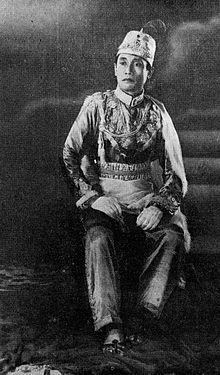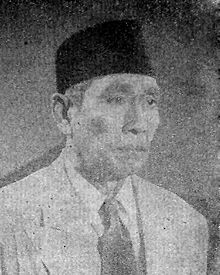Astaman (16 May 1900 – 20 August 1980) also known as Tirtosari, was an Indonesian actor active from the 1910s until the mid-1970s. He was a leading actor in the influential theatre company Dardanella and, after entering the film industry with 1940s Kartinah, acted in 43 films.
| Astaman | |
|---|---|
 Astaman in 1941 Astaman in 1941 | |
| Born | (1900-05-16)16 May 1900 Sidoarjo, Dutch East Indies |
| Died | 20 August 1980(1980-08-20) (aged 80) Jakarta, Indonesia |
| Nationality | Indonesian |
| Occupation |
|
| Years active | 1910–1974 |
| Children | 5 |
Biography
Astaman was born on 16 May 1900 in Sidoarjo, East Java, Dutch East Indies, as the son of an actor, Wagimin, and Sartipah, an actress. He attended elementary school there, only to drop out in his third year. At age ten Astaman joined his father's troupe Wagimin & Keluarga, which consisted of his father, mother, and two cousins. Astaman first sold tickets, later taking up acting and touring rural areas in East Java with the troupe. He left the troupe sometime in 1915, first to join the Theater se Souvenir, then the Constantinople Opera .
By the following year Astaman had abandoned Constantinople to join the troupe Dardanella in 1920, which was run by the Penang-born actor of Russian descent Willy A. Piedro and his native wife Devi Dja. The troupe, which was highly successful and travelled throughout Southeast Asia, helped Astaman rise to prominence. He played various roles with them, and starred in several of their performances, including Andjar Asmara's Dr Samsi and a stage adaptation of Kwee Tek Hoay's Boenga Roos dari Tjikembang. In a 1964 interview with the variety magazine Varia, he recalled that every time he played a king the European viewers would laugh loudly; Astaman later learned that his costume was that of a matador.
Astaman was married and has had five children. His son, Lilik Sudjio, who was born in 1930; later would become a film director. His other sons, Asmadi and Sutaman, was a musician and member of Dari Masa Ke Masa and Telerama orchestra group. In 1936, he joined Dardanella in a trip to India, hoping to produce a film version of Dr Samsi. This plan collapsed, and Dardanella disbanded: Piedro and Dja' went to America, while Andjar and Ali Joego formed their own troupes and returned to the Indies. Astaman returned separately, going to Kediri. After refusing a position with Njoo Cheong Seng's troupe Fifi Young's Pagoda, Astaman joined the group Tuan Mannuk.

Following the success of Albert Balink's Terang Boelan (Moonlight) in 1937, many theatre actors began migrating to film – including Astaman, who made his feature film debut in 1940. He co-starred along former Dardanella actress Ratna Asmara in Andjar's Kartinah, which saw him take the role of a doctor who falls in love with his nurse despite being married. The following year Astaman acted in three films for The Teng Chun's Java Industrial Film. When the studio closed following the Japanese occupation of the Indies in 1942, Astaman returned to the theatre. During the occupation he acted in a single film, the short propaganda piece Djatoeh Berkait.
In 1949, towards the end of the Indonesian National Revolution, Astaman joined Fred Young's studio Bintang Surabaya and began acting in its films, making his debut with Saputangan in 1949. He was taken by Djamaluddin Malik's Persari in 1951, staying with the company until 1958. Afterwards he focused mainly on the theatre, although he took acting jobs at several different companies until the late 1970s. In his later years he did some television acting.

On 20 August 1980, Astaman died at Dr. Mintohardjo Naval Hospital in Tanah Abang, Jakarta, after treated for hypertension which he suffered for 7 years and caused a brain hemorrhage at the age of 80. His body was laid at his son, Asmadi's, house at Perumnas Depok 1 in Depok, West Java, where he spent his final years there.
Filmography
In his seventy-four-year career, Astaman acted in 43 films over a period of 34 years. During this time he wrote the stories to two films.
Cast
|
|
Crew
- Hidup Baru (New Life; 1951)
- Tarmina (1954)
References
- Biran 1979, p. 66.
- ^ Jakarta 1980, p. 12.
- Erkelens 2022, p. 332.
- ^ National Library, Astaman.
- Varia 1964, Riwajat Astaman, p. 29.
- ^ JCG, Dardanella.
- ^ Varia 1964, Riwajat Astaman, p. 30.
- Filmindonesia.or.id, Tarmina.
- Biran 2009, p. 204.
- ^ Filmindonesia.or.id, Astaman.
- Filmindonesia.or.id, Kartinah.
- Biran 2009, pp. 319, 332.
Works cited
- "Astaman | Filmografi" [Astaman | Filmography]. filmindonesia.or.id (in Indonesian). Jakarta: Konfiden Foundation. Archived from the original on 30 June 2017. Retrieved 26 January 2013.
- "Astaman (Tirtosari)" (in Indonesian). Jakarta: National Library of Indonesia. Archived from the original on 17 February 2013. Retrieved 26 January 2013.
- Biran, Misbach Yusa, ed. (1979). Apa Siapa Orang Film Indonesia 1926–1978 [What and Who: Film Figures in Indonesia, 1926–1978]. Sinematek Indonesia. OCLC 6655859.
- Biran, Misbach Yusa (2009). Sejarah Film 1900–1950: Bikin Film di Jawa [History of Film 1900–1950: Making Films in Java] (in Indonesian). Jakarta: Komunitas Bamboo working with the Jakarta Art Council. ISBN 978-979-3731-58-2.
- "Dardanella". Encyclopedia of Jakarta. Jakarta City Government. Archived from the original on 17 February 2013. Retrieved 4 September 2012.
- "Kartinah". filmindonesia.or.id (in Indonesian). Jakarta: Konfiden Foundation. Archived from the original on 2 December 2013. Retrieved 25 July 2012.
- "Riwajat Astaman" [Tale of Astaman]. Varia (in Indonesian) (305): 15, 29, 30. 19 February 1964.
- "Tarmina". Filmindonesia.or.id (in Indonesian). Jakarta: Konfiden Foundation. Archived from the original on 7 March 2016. Retrieved 18 April 2013.
- Jakarta, Antara (22 August 1980). "Bintang Filem Astaman Meninggal". Kompas (in Indonesian). p. 12. Retrieved 25 June 2023.
- Erkelens, Jaap (2022). Dardanella, perintis teater Indonesia modern: duta kesenian Indonesia melanglang buana (in Indonesian). Penerbit Buku Kompas. ISBN 978-623-346-197-9.